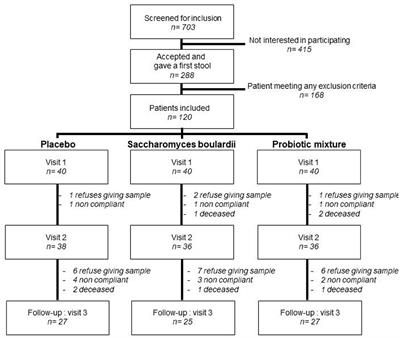|
Σφακιανάκης Αλέξανδρος
ΩτοΡινοΛαρυγγολόγος
Αναπαύσεως 5 Άγιος Νικόλαος
Κρήτη 72100
00302841026182
00306932607174
alsfakia@gmail.com
Αρχειοθήκη ιστολογίου
-
►
2023
(391)
- ► Φεβρουαρίου (200)
- ► Ιανουαρίου (191)
-
►
2022
(2843)
- ► Δεκεμβρίου (161)
- ► Σεπτεμβρίου (219)
- ► Φεβρουαρίου (264)
- ► Ιανουαρίου (280)
-
▼
2021
(5625)
- ► Δεκεμβρίου (231)
- ► Σεπτεμβρίου (345)
-
▼
Μαρτίου
(576)
-
▼
Μαρ 07
(34)
- Relationship between tumor cell infiltration and 5...
- Patterns of treatment failure in patients with pro...
- Influence of glioblastoma contact with the subvent...
- SMARCA4 promotes benign skin malignant transformat...
- Identifying a novel 5-gene signature predicting cl...
- Paeonol inhibits proliferation and induces cell ap...
- Head-to-head comparison of two rapid high-throughp...
- Midazolam for sedation before procedures in adults...
- COVID-19 related increase in childhood tics and ti...
- Longitudinal assessment of anti-SARS-CoV-2 immune ...
- Sex differences in the evolution of neutralizing a...
- Shedding of culturable virus, seroconversion, and ...
- Failure of nonoperative management in patients wit...
- Bartonella Neuroretinitis
- Nucleoside‐modified messenger RNA (modRNA) COVID‐1...
- The role of teicoplanin in the treatment of SARS‐C...
- Is obesity a manifestation of systemic racism? A t...
- Systematic literature review of neutralizing antib...
- Voltammetry of 7-dehydrocholesterol as a new and u...
- Non-specific effects of BCG vaccination on neutrop...
- Hearing about the Big Bang for the First Time
- Characterization of pyridine biodegradation by two...
- Enhanced removal of arsenic from water by using su...
- Induction of apoptosis in Trypanosoma brucei follo...
- [Series] Revisiting maternal and child undernutrit...
- [Series] Mobilising evidence, data, and resources ...
- Postnatal Major Depressive Disorder
- Do Probiotics During In-Hospital Antibiotic Treatm...
- Prevalence and Factors Associated With Body Pain
- Systematic Review of Potential Occupational Respir...
- Preoperative tracheotomy as reflection of tumor si...
- The aspartate aminotransaminase/alanine aminotrans...
- Non-negative matrix factorization-based time-frequ...
- Mu-Opioid Receptor Expression in Laryngeal Cancer
-
▼
Μαρ 07
(34)
- ► Φεβρουαρίου (620)
-
►
2020
(2065)
- ► Δεκεμβρίου (535)
- ► Σεπτεμβρίου (222)
- ► Φεβρουαρίου (28)
-
►
2019
(9608)
- ► Δεκεμβρίου (19)
- ► Σεπτεμβρίου (54)
- ► Φεβρουαρίου (3791)
- ► Ιανουαρίου (3737)
-
►
2018
(69720)
- ► Δεκεμβρίου (3507)
- ► Σεπτεμβρίου (3851)
- ► Φεβρουαρίου (8116)
- ► Ιανουαρίου (7758)
-
►
2017
(111579)
- ► Δεκεμβρίου (7718)
- ► Σεπτεμβρίου (7549)
- ► Φεβρουαρίου (10753)
- ► Ιανουαρίου (10529)
-
►
2016
(16402)
- ► Δεκεμβρίου (7478)
- ► Φεβρουαρίου (900)
- ► Ιανουαρίου (1250)
! # Ola via Alexandros G.Sfakianakis on Inoreader
Η λίστα ιστολογίων μου
Κυριακή 7 Μαρτίου 2021
Do Probiotics During In-Hospital Antibiotic Treatment Prevent Colonization of Gut Microbiota With Multi-Drug-Resistant Bacteria? A Randomized Placebo-Controlled Trial Comparing Saccharomyces to a Mixture of Lactobacillus, Bifidobacterium, and Saccharomyces
Εγγραφή σε:
Σχόλια ανάρτησης (Atom)
Αρχειοθήκη ιστολογίου
-
►
2023
(391)
- ► Φεβρουαρίου (200)
- ► Ιανουαρίου (191)
-
►
2022
(2843)
- ► Δεκεμβρίου (161)
- ► Σεπτεμβρίου (219)
- ► Φεβρουαρίου (264)
- ► Ιανουαρίου (280)
-
▼
2021
(5625)
- ► Δεκεμβρίου (231)
- ► Σεπτεμβρίου (345)
-
▼
Μαρτίου
(576)
-
▼
Μαρ 07
(34)
- Relationship between tumor cell infiltration and 5...
- Patterns of treatment failure in patients with pro...
- Influence of glioblastoma contact with the subvent...
- SMARCA4 promotes benign skin malignant transformat...
- Identifying a novel 5-gene signature predicting cl...
- Paeonol inhibits proliferation and induces cell ap...
- Head-to-head comparison of two rapid high-throughp...
- Midazolam for sedation before procedures in adults...
- COVID-19 related increase in childhood tics and ti...
- Longitudinal assessment of anti-SARS-CoV-2 immune ...
- Sex differences in the evolution of neutralizing a...
- Shedding of culturable virus, seroconversion, and ...
- Failure of nonoperative management in patients wit...
- Bartonella Neuroretinitis
- Nucleoside‐modified messenger RNA (modRNA) COVID‐1...
- The role of teicoplanin in the treatment of SARS‐C...
- Is obesity a manifestation of systemic racism? A t...
- Systematic literature review of neutralizing antib...
- Voltammetry of 7-dehydrocholesterol as a new and u...
- Non-specific effects of BCG vaccination on neutrop...
- Hearing about the Big Bang for the First Time
- Characterization of pyridine biodegradation by two...
- Enhanced removal of arsenic from water by using su...
- Induction of apoptosis in Trypanosoma brucei follo...
- [Series] Revisiting maternal and child undernutrit...
- [Series] Mobilising evidence, data, and resources ...
- Postnatal Major Depressive Disorder
- Do Probiotics During In-Hospital Antibiotic Treatm...
- Prevalence and Factors Associated With Body Pain
- Systematic Review of Potential Occupational Respir...
- Preoperative tracheotomy as reflection of tumor si...
- The aspartate aminotransaminase/alanine aminotrans...
- Non-negative matrix factorization-based time-frequ...
- Mu-Opioid Receptor Expression in Laryngeal Cancer
-
▼
Μαρ 07
(34)
- ► Φεβρουαρίου (620)
-
►
2020
(2065)
- ► Δεκεμβρίου (535)
- ► Σεπτεμβρίου (222)
- ► Φεβρουαρίου (28)
-
►
2019
(9608)
- ► Δεκεμβρίου (19)
- ► Σεπτεμβρίου (54)
- ► Φεβρουαρίου (3791)
- ► Ιανουαρίου (3737)
-
►
2018
(69720)
- ► Δεκεμβρίου (3507)
- ► Σεπτεμβρίου (3851)
- ► Φεβρουαρίου (8116)
- ► Ιανουαρίου (7758)
-
►
2017
(111579)
- ► Δεκεμβρίου (7718)
- ► Σεπτεμβρίου (7549)
- ► Φεβρουαρίου (10753)
- ► Ιανουαρίου (10529)
-
►
2016
(16402)
- ► Δεκεμβρίου (7478)
- ► Φεβρουαρίου (900)
- ► Ιανουαρίου (1250)



Δεν υπάρχουν σχόλια:
Δημοσίευση σχολίου